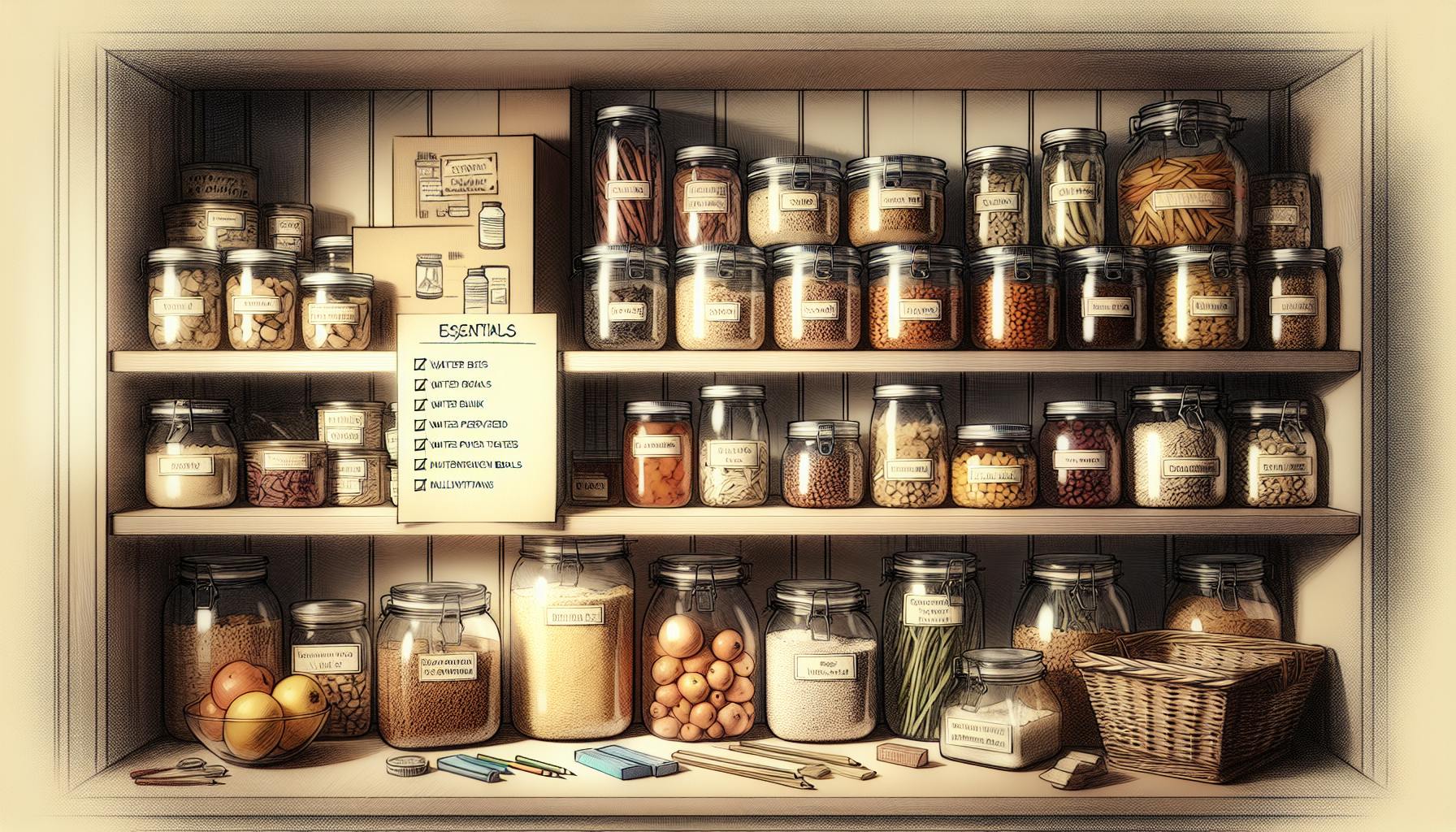Introduction: Transforming Waste into Bounty Through Regrowing Food Scraps
For any prepper looking to achieve self-sufficiency, making the most of available resources is key. An often overlooked opportunity exists right in your own kitchen - the ability to regrow vegetables, herbs, and more from common food scraps. Onion bottoms, carrot tops, garlic cloves, avocado pits, and other scraps can be repurposed into fresh produce with minimal effort and cost. Regrowing these food scraps reduces waste, provides renewable and self-sufficient food sources, and allows you to grow nutritious produce for free. In this comprehensive guide, we'll explore the immense value of foods you can regrow from scraps and how mastering this skill can greatly aid your emergency preparedness through enhanced food security.
Let's start by looking at the main benefits regrowing food scraps offers for preppers:
-
It drastically cuts down on food waste by giving scraps new life. Simply composting waste is great, but regrowing takes reuse to the next level.
-
Regrown foods become a perpetual source of produce completely independent of grocery stores or markets. This self-sufficiency is invaluable in an emergency when other supply lines are disrupted.
-
Regrowing makes use of spare space and soil while only requiring scraps destined for the trash. It's an extremely frugal, low-cost way to grow nutritious food.
-
As environmental awareness grows, regrowing scraps is a sustainable green practice that eliminates food waste from entering landfills. Every little bit of reduced waste helps protect our planet.
-
The ability to regrow vegetables, fruits, and herbs year-round significantly enhances a prepper's food security. Having access to fresh produce through all seasons is a prepper's dream!
In summary, regrowing scraps is all about transforming trash into treasure - converting overlooked waste into valuable regenerated food sources. Let's explore how to make this happen.
Selecting the Best Food Scraps for Regrowing Bounty
Not all food scraps are equal when it comes to regeneration potential. Certain characteristics make some food leftovers ideal candidates for regrowing, while others have very slim chances of successfully sprouting. When choosing which scraps to regrow, look for:
-
Vegetables with vigorous root systems - Onions, garlic, carrots, beets, sweet potatoes, and turnips regenerate readily from their hearty roots and underground storage organs. These stubborn root crops are survivors.
-
Fruits and veggies with viable seeds - Avocados, tomatoes, peppers, eggplants, cucumbers, pumpkins, citrus fruits, apples, and stone fruits like peaches contain seeds capable of sprouting new growth. Extract and plant them.
-
Leafy greens and herbs - Lettuce, spinach, celery, bok choy, cabbage, fennel, leeks, basil, mint, parsley, cilantro and other leafy greens will regrow from their cut stem ends.
-
Certain fruits like pineapples and citrus - While limited, you can propagate new plants from crown cuttings or seeds saved from rinds and cores.
Once chosen, prep scraps by removing any rot and cutting away damaged roots or ends. Ensure cut surfaces are dry before planting in suitable containers with well-draining potting mix. Allow 1-3 inches of soil depth depending on scrap size. Situate in a sunny spot. Water soil when it dries 1 inch below the surface. Stagger plantings every 2-3 weeks for ongoing harvests. With ideal care, you'll reap renewable produce!
Step-by-Step Instructions for Regrowing Popular Kitchen Scraps
Ready to start regrowing? Let's get into the specifics of planting, caring for, and harvesting some favorite kitchen cast-offs:
Onions - Slice off the dry root end of onions leaving at least 1/2 inch of roots. Plant root-side down in pots with the tips just above the soil surface. Place in full sun. Green shoots will emerge in 2-3 weeks. Harvest green onions once they reach 6 inches tall. For mature bulbs, transplant outdoors when 8 inches tall and space 4-6 inches apart.
Garlic - Break bulbs into individual cloves. Plant 1-2 inches deep and 2 inches apart in containers or garden beds, with the pointed end facing up. Mature garlic is ready to harvest when leaves turn brown and die back in mid-summer. Gently dig up bulbs and let cure for 2 weeks in a dry spot before storing in a cool pantry.
Carrots - Cut off the leafy green tops, leaving about 1 inch of stem attached. Place cut-side down in a shallow bowl or saucer with water just covering the bottom stem. New leafy greens will sprout from the tops within days. For new carrots, suspend just the top 1/2 inch of the root end in water with the greens above water. Roots and greens will begin growing. Transplant the crown to soil after sufficient rooting occurs.
Lettuce - Cut off the base of lettuce heads about 1 inch above the root. Place cut-side down in a bowl with 1/2 inch of fresh water. New leaves will begin sprouting from the base in just a few days. Transfer to soil when a vigorous root system develops. Harvest outer leaves as needed. The core will continue producing new growth all season.
Celery - Cut 3-4 inches off the base of celery stalks. Place cut-side down in a shallow dish of water in a sunny window. Change water daily to prevent rotting. Tender new celery growth will emerge within 1-2 weeks. Transfer to pots once sufficiently rooted and keep soil consistently moist. Harvest outer stalks as needed while inner stalks continue growing.
With a little time and effort, these simple steps can provide you with bountiful self-grown produce to aid your self-sufficiency. Get creative with the food scraps you choose to regrow - the possibilities are nearly endless!
Leveraging Regrown Scraps for Enhanced Food Self-Sufficiency
Once you perfect the regrowing process, a whole new world of scrap-fed foods opens up! Here are some ways to leverage regrown produce for increased self-sufficiency:
-
Use regrown green onions, garlic, carrots, and herbs to add homegrown flavor to soups, stews, sauces, and other dishes.
-
Preserve excess tomatoes, peppers, beans, and other produce by canning or pickling to enjoy the taste of summer during cold winter months.
-
Interplant compatible vegetables like pole beans and cucumbers with regrown corn or tomatoes. The plants will work together for dual harvests from the same soil space.
-
Stagger regrowing plantings 2-3 weeks apart to guarantee continual yields. With smart timing, you can eliminate grocery store trips entirely!
-
Establish a sustainable garden ecosystem by regrowing vegetable scraps, composting plant remains, and saving seeds. Enjoy homegrown food year-round!
Regrowing food scraps allows preppers to transform trash into edible abundance. Let your imagination run wild with inventive ways to leverage nature's free gifts!
Creative Ways to Use and Preserve Your Regrown Bounty
Looking for inspiration on how to enjoy your regrown bounty? Here are some inventive ways to make the most of scraps-turned-produce:
-
Culture extra onion bulbs and carrot ends into tangy homemade sauerkraut packed with probiotics.
-
Blend lettuce cores and celery leaves into a refreshing gazpacho soup. Garnish with cucumber ends.
-
Infuse apple cider vinegar with garlic scapes, jalapeno ends, and fresh dill for a zesty salad dressing.
-
Candy young ginger root slices in sugar syrup for a sweet-spicy addition to desserts or cocktails.
-
Ferment green bean ends with whey into crunchy dilly beans perfect as a tangy snack or sandwich topper.
-
Simmer potato peels and carrot tops into a light, mineral-rich broth, perfect as a base for hearty soups.
-
Juice tomato cores, beet leaves, and carrot greens for a hydrating, nutrient-dense beverage.
Don't let anything go to waste - with creativity, you can find uses for all your harvested scraps!
Maximizing Regrown Food Yields Throughout the Year
While regrowing vegetable scraps is easiest in spring and summer, with planning you can enjoy fresh homegrown produce in every season:
-
Make succession plantings of quick-growing greens like lettuce for continual harvests.
-
Extend the fall growing season by using cold frames or hoop houses to protect plants from frost.
-
Move containers inside and supplement natural light with full spectrum LED grow lights as winter days shorten.
-
Time summer sowings of carrots, beets, onions and garlic to mature before your first fall frost date.
-
Preserve peppers, tomatoes, beans and more during peak harvests when plants are most productive.
-
Overwinter hardy plants like kale, carrots, beets and garlic outdoors under thick insulating mulch.
With season extension tricks like these, your kitchen scraps can keep producing food through every season. Ample rewards await those willing to put in the time and effort!
Start Regrowing Today for Enhanced Preparedness
As we've covered, repurposing food scraps into homegrown produce is tremendously valuable for preppers seeking self-sufficiency. Regrowing allows you to reduce waste, save money, and sustainably cultivate renewable food sources. This guide has provided the fundamental knowledge needed to find regrowing success.
Key takeaways include choosing the best vegetable scraps, following proper planting techniques, leveraging regrown foods creatively, and maximizing harvests year-round. While it takes patience and practice, with time you can master the art of scrap regrowing. Remember, the ability to grow food from waste is invaluable when striving for self-reliance.
We hope this article has inspired you to view your food scraps as the seeds of abundance. We encourage you to begin experimenting with regrowing your kitchen cast-offs right away. Start collecting your scraps, prep them for planting, and tend them carefully. Before long, you'll be rewarded with homegrown produce through every season! Please share your regrowing experiences with us here at WeLovePrepping as we work together to reduce waste and expand our collective food security. Happy regrowing!


